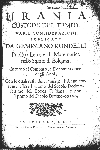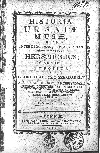

Several astronomical treatises have been named after Urania, such as the astronomical poem by Giovanni Pontano Urania sive de stellis (1505), the medical-astronomical treatise by Antoine Mizauld Aesculapii et Uraniae medicum simul et astronomicum ex colloquium conjugium (1550), the work by Rudolph Goclenius Urania cum geminis filiabus, una germana et altera spuria, hoc est, Astronomia et Astrologia (1602) and the Telescopio d'Urania, printed under the pseudonym of Sofistico Indovino, on the occasion of the comet of 1664. In this century can be remembered, among others, the books Problemi di Urania by Francesco Brioschi (1928) and Urania nei secoli by Fede Paronelli (1945).
The library of the Department of Astronomy of Bologna owns two further treatises named after the Muse of astronomy:
Urania custode del tempo. Varie considerazioni ... intorno al computo e denominazione degli anni ...
In Bologna, per gli Eredi Pisarri, 1700.
pp. 45. 4°.
DC - 4° - 149
Riccardi
 In Urania custode del tempo
Geminiano Rondelli faces a
chronological problem which, at those times, turned out to be a real
controversy, resumed in 1800: is the year 1700 the first one of the XVIIIth
century or the last one of the XVIIth?
Nowadays the problem appears someway odd, since the year ending with double
zeroes can not be the first one of the century, but at the time it gave
occasion to several publications on this subject.
In Urania custode del tempo
Geminiano Rondelli faces a
chronological problem which, at those times, turned out to be a real
controversy, resumed in 1800: is the year 1700 the first one of the XVIIIth
century or the last one of the XVIIth?
Nowadays the problem appears someway odd, since the year ending with double
zeroes can not be the first one of the century, but at the time it gave
occasion to several publications on this subject.
Geminiano Rondelli (Roncoscaglia 1652-1735) was a mathematician and taught hydraulics at Bologna University; he also was the first librarian of the Bologna Institute of Sciences. His edition of Euclid's Elements was quite appreciated by his contemporaries, and he also composed a treatise of trigonometry and various papers of hydraulic subject.
Historia Uraniae Musae, quam inter deos, deasque planetarias recens detexit Herschelius.
Viennae, typis Joan. Thom. nob. de Trattnern, 1788.
pp. 48. 8°.
Misc. Leg. VII. 1
Poggendorff
 In his Historia Uraniae Musae
Georg Szerdahely tells the tale of the origin
of the constellation of Sextans: it was a gift of Apollo to Urania, which
remained concealed to the human race, until Hevelius described it, in 1670:
In his Historia Uraniae Musae
Georg Szerdahely tells the tale of the origin
of the constellation of Sextans: it was a gift of Apollo to Urania, which
remained concealed to the human race, until Hevelius described it, in 1670:
Instrumento astronomico, partem sextam Circuli complectente, quod Sextantem dicunt astronomi, olim Apollo donavit Uraniam in Parnasso coelestia dimetientem. Hunc subinde Phoebus (Urano sic jubente) inter astra retulit, mortalibusque incognitus fuit usque ad tempora cel. Hevelii, astronomi Dantiscani, a quo circa Annum 1670, dum catalogum Fixarum conderet, primum inter Leonem & Hydram repertus & observatus, atque subinde Aeri inter ceteras constellationes incisus cum astronomis sub nomine Sextans Uraniae, communicatus est.
Georg Szerdahely (Vath 1740-1808), jesuit and professor of rhetoric, taught aesthetics at the University of Buda. He was knight of St.Stephen and mitred abbot at St.Maurice in Both. The first edition of the Historia Uraniae Musae appeared in the same year 1788, included in the Ephemerides Vindobonenses by Hell.



| Biblioteca del Dipartimento di Astronomia Pierluigi Battistini, Laura Peperoni e Marina Zuccoli |